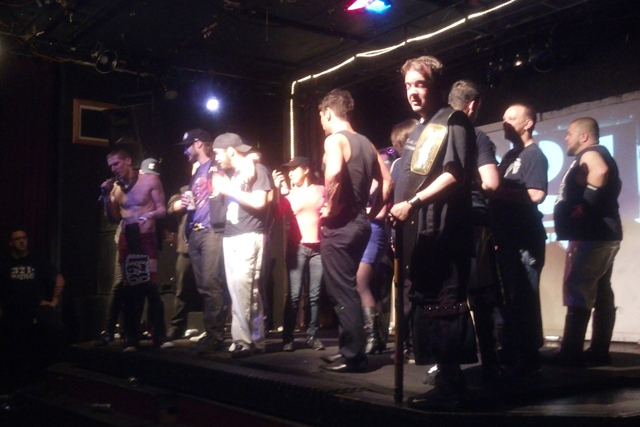
Is professional wrestling real or pretend? Washington State laws define a “wrestling show” or “wrestling exhibition” as “a form of sports entertainment in which the participants display their skills in a physical struggle against each other in the ring and either the outcome may be predetermined or the participants do not necessarily strive to win, or both.” But is a lucha libre show — for that matter any type of professional wrestling show — real or pretend?
In his book “The World of Wrestling”, Roland Barthes defines professional wrestling as a mode of spectacle which combines athletics and theatrical performance. The Department of Licensing puts wrestling in the same category as boxing and mixed martial arts (MMA), and has oversight of wrestling events in the state of Washington.
If you’ve ever watched wrestling outside of the Olympics, yes, I am talking about the WWE (World Wrestling Entertainment) you know the outcomes of the matches are predetermined in order to heighten entertainment value. All combative maneuvers are executed with the full cooperation of those involved and carefully performed to lessen the chance of actual injury. I’m not saying The Rock isn’t talented. I’m not saying wrestling is fake. What I am saying is professional wrestling is a long way from boxing and MMA. The skills of the wrestlers do not determine the outcome of the match. Instead, writers work on plots and storylines well in advance, and every match is another chapter in the story. Who wins and who loses is all in the script.
Simply calling wrestling “fake” is like calling an action movie fake. When you see a movie, you know that the actor didn’t really jump a burning car over an exploding bridge, but you’re still entertained. Stunt people and special effects crews worked to make those scenes seem real, and their work can be very impressive.
“The intent with our shows is to put on a good show and not get hurt,” said Josh Black. “If somebody gets hurt at one of our shows it’s an accident. If somebody doesn’t get hurt at one of their [MMA/boxing] shows, it’s a shitty show.”

Now House Bill 2573 could loosen restrictions on professional wrestling in Washington state. The bill has passed unanimously in a committee, and is expected to be voted on in the house by Tuesday. It’s sponsored by Rep. Zack Hudgins.
“Each individual wrestler has to be licensed just like an MMA (mixed martial arts) fighter has to be licensed, we have to get a blood test and a physical. In order to put on a show, you have to pay a booker’s fee, you have to pay a percentage of the ticket, in addition to some sort of fee that involves the tickets. We have to have paramedics on site the whole time which, if our sport is done correctly, then no one gets hurt any way,” said Michael Leveton, who is a Lucha Libre Volcanico wrestler.
“These laws are from a time when wrestling was considered a real athletic event,” said Black, who ran Seattle Semi Pro wrestling from 2003 – 2008.
Based upon the DOL requirements, a rough breakdown of expenses a wrestling promotion incurs for a single event:
- A promoter’s license: $500
- 6% of the gross receipts paid for admission must be paid to the State, plus $1 per ticket sold
- Protective guardrail around the ring: $100-$170
- An ambulance plus 2 EMTs must be onsite for the entirety of the event (usually 2-3 hours): $110 per hour, plus a minimum charge of one hour of drive time.
- “Adequate” (definition unclear) security staffing, but clearly this could create additional costs.
This of course, is all before the promoter pays any space rental fee, and pays the performers, the emcee, ring announcers, DJs, and so on.
Additionally, when a promoter intends to have an event, he or she is required to have an inspection by a state-licensed inspector. The DOL site lists only three inspectors: two, who have expired licenses and one, who is “pending documentation.” The latter of which illustrates that even if a promoter wants to eat all of the costs to have an event, odds are she would have trouble doing so legally by the State by the sheer inaccessibility of an inspector.
It’s also worth noting that each individual wrestler must be licensed. This Combative Sports License must be renewed and paid for annually by the performer, and requires:
- a physical examination
- an STD blood panel
- a urine test
- a $25 fee to the State
Of the 27 promoter licenses for Washington, only 2 — WWE and TNA — are active. Similarly only two Pacific Northwest announcers are licensed, with the remaining 10 or so licenses belonging to WWE announcers. Further, of the 200 viewable wrestling licenses listed, the only active licenses belong to WWE wrestlers.
Lacking diversity within the licensing, illustrates a system that prevents small companies from flourishing, or pushes them underground, often forcing performers to wrestle in less than ideal conditions.
In either case Washington State is not benefiting financially, and the potential for a pro wrestling scene — and all of the business therein — is being squandered. The net gain for performers, local business, and Washington State alike ultimately lies in changing the current regulations, which are proving to keep pro wrestling in a perpetual choke-hold.

Leave a Reply